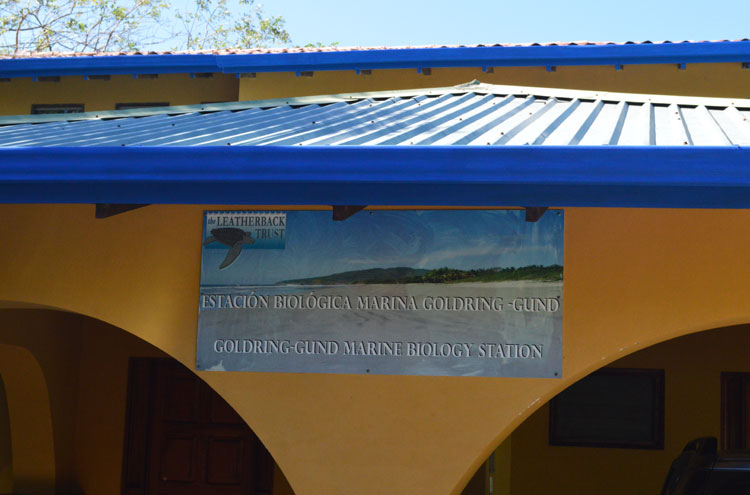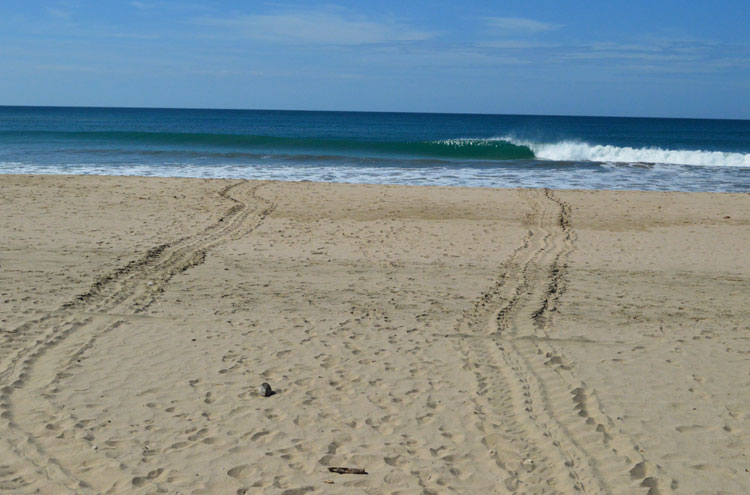

|
Wow, what an amazing first night on the beach at Playa Grande. It is now 2:30 in the morning, and I'm exhausted, but too tired to actually sleep. It has been a long, exciting day. I started off the day by learning a really sweet Costa Rican expression. The verb amanecer means "to dawn" and it is what the days does every morning. When used for people, it generally means to wake up in the morning. But Costa Ricans take it a step further, by greeting people in the morning with the intriguing question ¿Cómo amanecío? It could be translated as "how did you greet the dawn?" After greeting me with this costariquenismo, the taxi driver left the hotel in Liberia and started out on the short distance to the airport. We soon found the road was blocked by a burning bus, so we sat in traffic for about half an hour. I knew I was early to meet up with the Earthwatch team, but started to worry when cars came to a complete standstill. I didn't need to worry though; I ended up extremely early. I met Ariana and Chris right away as soon as I arrived at the terminal, but we had to wait for four more volunteers who were arriving over the next three hours. Arie and Chris are biologists with the Leatherback Trust, an organization which has worked for 25 years to protect the critically endangered leatherback turtle (Dermochelys coriacea). It was because of the Leatherback Trust's research and the volumes of data they collected that the Costa Rican government agreed to establish Parque Nacional Marino Las Baulas in 1991. The park takes its name from the Spanish word for leatherback turtle, which is baula.  The Goldring-Gund Marine Biology Station, our beach house on Playa Grande After all the volunteers had gathered, we made the hour-long drive to the coast and Tamarindo. We arrived at the Goldring-Gund Marine Biological Station, our beach house on Playa Grande. There we met the other biologists who are working with the Leatherback Trust, seven of them in all. We filled out paperwork and got an orientation to the house, the area, and the project we will be working on for the next nine days. Then we went out to dinner at Kike's (pronounced Kee Kays), a local restaurant where we will have breakfast and dinner each day. That should be fine; the food is excellent. I had a casado con carne, a tender steak with rice and beans, salad, and a nice cool mango con leche (mango with milk and ice - tastes like a milkshake, but light and healthy). After dinner, it was time to start work on the beach. We drove a short distance to one of the entrances of the national park. Arie and I patrolled the southern part of Playa Grande, while other volunteers and biologists worked the northern part of the beach, as well as Playa Ventanas, which lies even further to the north of Playa Grande. The beach is divided into 100-meter segments, marked by discrete sticks placed in the vegetation at the top of the beach. The system was first developed by poachers, who paid for the rights to a segment of the beach; the eggs of any turtle that came up within that segment belonged to that poacher by rights. When poaching was banned and the Leatherback Trust began to monitor the turtle nesting sites, they took over the marking system and used it to patrol the beach. We walked from our starting point, which was marker #25, down to marker #36, where Playa Grande comes to an end at the Tamarindo Estuary. We then turned around and walked back as far north as marker #11, going up and down the beach for the next seven hours. Fairly early in the night, we came upon an olive ridley sea turtle (Lepidochelys olivacea) just as she was coming out of the water. I was startled at her speed; she had a powerful determination to reach the higher ground of the beach that ran along the edge of the forest. We watched as she methodically dug out the egg chamber, first reaching one of her hind flippers into the hole and digging out the sand. She would slowly raise the flipper and carefully deposit the sand outside the hole. Then she would repeat this process with the other hind flipper, alternating the work until the hole was deep enough to hold the eggs, about half a meter (a foot and a half). We thought it was going to be difficult to get a good count of the eggs, because the turtle had planted the edge of her shell very close to the beach. I laid down on the beach, just inches from her tail, but I could barely see down into the egg chamber. I could see the movement of her cloaca, an opening that is used to excrete the eggs. It was reverberating every eight to ten seconds, and I was able to catch a glimpse of a pingpong ball-sized egg drop into the hole. So I began counting the eggs. 43. Small number for a ridley, but it is near the end of the season. Later that night we came upon the big prize - a baula, a leatherback sea turtle. I was astonished at her size as I quietly approached her. While another volunteer counted the eggs (71), Arie and I took measurements of her width and length. I held the measuring tape close to the turtle's neck while Ari pulled it down along the bony ridge that runs the length of the back (144.4 centimeters, almost 5 feet long), which does not include the head. The turtle seems to go into a type of trance while she is laying her eggs and does not appear to be disturbed by our presence, although we still try to maintain a respectful calm and silence. Nevertheless, I could see the look in her eyes as I held the tape on her back, saw her looking me in the eye. She gently heaved up and down as she deposited the eggs in the deep chamber she had dug. We recorded any scars and injuries we could find, and peeled off the barnacles that had become attached to her leathery back. We heard over the radio that one of the other groups had found a couple of black turtles (Chelonia mydas agassizi). They did a "false crawl" though, meaning they emerged from the ocean, came up onto the beach, but didn't excavate a nest. They simply returned to the sea after a brief walk around the beach. I was thrilled that I got to see two of the three species of sea turtles that come to this beach on the first night. I hope to see a black turtle sometime in the next week. All of this was taking place in almost total darkness. There were a few lights from the town of Tamarindo at the southern end of the beach, but Playa Grande is part of the national park, so it doesn't have a lot of development. We used low intensity headlamps with red filters taped over the light, because red is the color that sea turtles least respond to when they come onto land. The main lights we saw were the bioluminescent organisms that floated in on the surf and the distant heat lightning that flashed across the horizon. It didn't seem like a thunderstorm could be coming in, because the clear starry skies overwhelmed us with their majesty. A humbling, mind-boggling night.  The next morning: Upward and downward tracks of a black turtle |
||||
|
||||
|
© 2015 Michael Hanrahan
|